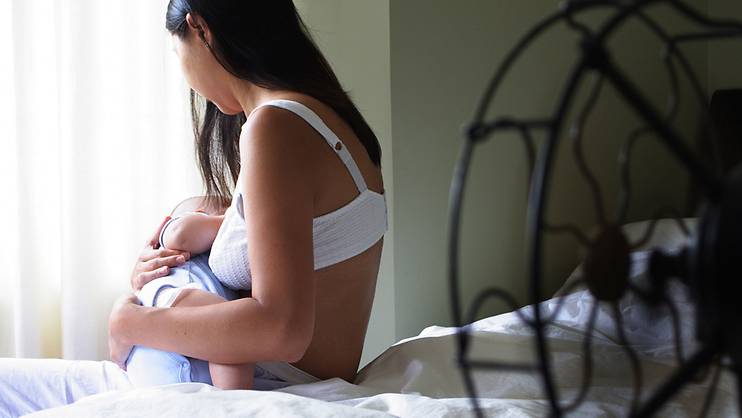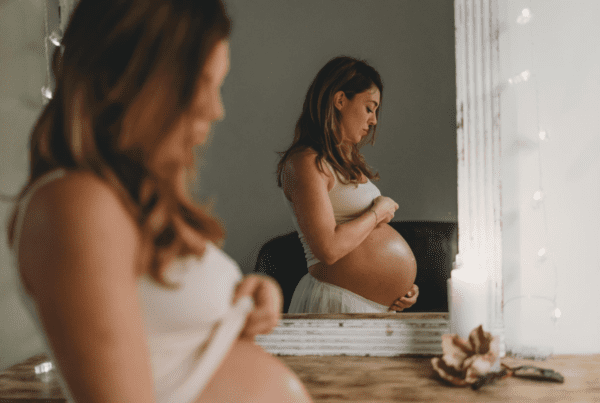If you haven’t thought about nursing bras yet, now is the time. Although your breast size will change as your milk comes in and then change again after you establish a routine, it’s important to start your research before you need one. The options are not limitless, but what each nursing bra, in terms of comfort, ease of nursing, ease of pumping, support, and how they look under your clothes, are all different! Today we are going to cover the do’s and don’ts of nursing bras- from different brands, tips on how to find the right fit, and all you need to know when searching for that perfect nursing bra.
When is the best time to start looking for a nursing bra?
After you give birth and for the first month, your breasts will swell and rapidly change size until they regulate milk supply. We suggest using a non-wired, stretchy, seamless nursing bra that grows with you. A comfortable, non-restrictive bra is paramount to help avoid complications such as mastitis. Once your milk flow is regulated, which is at 4+ weeks, your cup size will stabilize, and you can now start wearing any flexi-wire bras.
What to look for in a nursing bra?
The first thing to look for is fit, with comfort and accessibility coming in a close second and third. The type of nursing bra you purchase should be based entirely on your personal preference, but any style you choose should fit properly, be comfortable to wear, and provide easy access for nursing.
There are many features to good quality nursing bras. Here is what we suggest you look for:
- Reinforced straps for support and comfort
- Supportive lower cup with a strong mid layer for lift
- Good top cup stretch for growth without restriction
- Extended 4 to 6 hook and eye closure to accommodate expansion of the ribcage
- Double layered back band for support and durability
- Quality tested fabric to avoid irritation
- Internal seams to avoid abrasion
- Easy drop cups to make feeding and pumping easier
Different types of nursing bras:
There are many different types of nursing bras on the market today. If you have just had your baby, we recommend a seamless bra because it is soft and comfortable and can grow with you. If you want a bit more support, we suggest a soft cup non-wire bra. This type of bra is a bit more structured, supportive, and functional.
If you are about 6 to 8 weeks after birth, and your breasts have settled, consider a flexible-wire bra. These provide great shape, separation, lift, and support without restriction. Another good alternative is a contour bra which will offer support, modesty, and versatility. We also suggest a sports nursing bra with a flexi wire. These will offer support and function so you can stay healthy and busy, and exercise comfortably.
How to determine the perfect nursing bra size?
Proper fit is so important because this will help you maintain good breast health. You should be fitted for a new bra as soon as your current bra starts to feel uncomfortable, too tight, or too loose. We found an online fit calculator here that we think will come in handy!
Now, let’s determine your bra size by following these simple steps. Make sure you are wearing a bra while you are measuring and to keep the measuring tape level. We recommend a soft tape measure! Remember, these are just starting points. The most important thing is to try on bras to find a fit that is comfortable on you.
- Measure around the torso just under your arms, but above your breasts. If this measurement is an odd number, or a half number, round it up to an even number.
- For cup size, measure around the FULLEST part of your bustline. Subtract the band size from the cup size. Each 1” difference equals a cup size.
- 1” = A
- 2” = B
- 3” = C
- 4” = D
- 5” = E or DD
The do’s and don’ts of nursing bras:
- Don’t buy the wrong size! So many women are wearing the wrong size bra! If you aren’t sure about your own measuring capabilities, head over to a lingerie shop or department store. They can measure and fit you. The wrong nursing bra size won’t support you properly and might result in sagging or ligament damage.
- Don’t sacrifice quality for price! We know nursing bras are expensive but invest in bras that are made from quality fabrics and trims. Cheaper bras will lose their elasticity and ability to offer support after a few washes.
- Do get fitted for nursing bras! Getting fitted at a lingerie store or department store is worth the effort. A bra fitter is trained and will not only assess your breast and body shape but will be able to provide you with the options they have available. We know that buying the perfect bra while you are breastfeeding can be frustrating but getting fitted will cut out the frustration.
- Don’t buy a bigger cup size to allow for fluctuation! Breastfeeding women should purchase nursing bras that fit them correctly. Don’t buy bras that have extra room in the cups because it will not sit nicely under your clothing or correctly support you.
- Don’t buy too few nursing bras! For the first 6 weeks post birth your breasts and body will change a lot. Supportive seamless bras will change and stretch with your changing shape. Once your breasts have stabilized, with only small let-down fluctuations, wear a flexible-wired bra that is designed to support cup sizes. We suggest you purchase 6 bras. 3 for the transitional period and 3 for the stabilization period. This way you have one to wear, one to be washed, and one in your drawer!
- Don’t wear a nursing bra from a previous pregnancy! Good nursing bras last around 6 to 9 months. You’ve worn them, washed them, and haven’t put them on in at least a year! You need to take into consideration that your bra size might not be the same after each baby, and the bra will have lost its ability to support.
- Do purchase the correct band size! You might purchase your first nursing bra at about 9 months of pregnancy, but your rib cage will change after the baby comes. This is why we suggest the first bras are seamless and can change with your body. When you are buying your nursing bras, they should have 6 to 8 hook and eye closures, and the back band, which provides 80% of the support, should fit perfectly on the LOOSEST hook. As your rib cage contracts, you will be able to move to tighter hooks.
- Don’t wear wired bras while your breast size is fluctuating! We can’t say it enough to go seamless while your breast size is still fluctuating. A flexible-wired bra can be worn from pregnancy to about 4 weeks after the baby has arrived.
- Don’t compress your breasts! Your breasts will feel extremely sensitive during this time, so purchase bras that separate and support your breasts. Not only will the bras feel extremely comfortable but will appear flattering too. A good rule of thumb is that you should be able to push the center front of the bra comfortably between your breasts.
- Do consider your wardrobe! There are many nursing bras available on the market today that range from everyday basics, contour, soft cups, and fashion. Purchase nursing bras that will work not only with your lifestyle but will make you feel great.
Motherhood Center carries a large selection of nursing bras, including our newest brand by Cake Lingerie. We would love to have you come in for all your nursing bra and breastfeeding needs so we can fit you and have you feeling like a million bucks during this special bonding time with baby!



